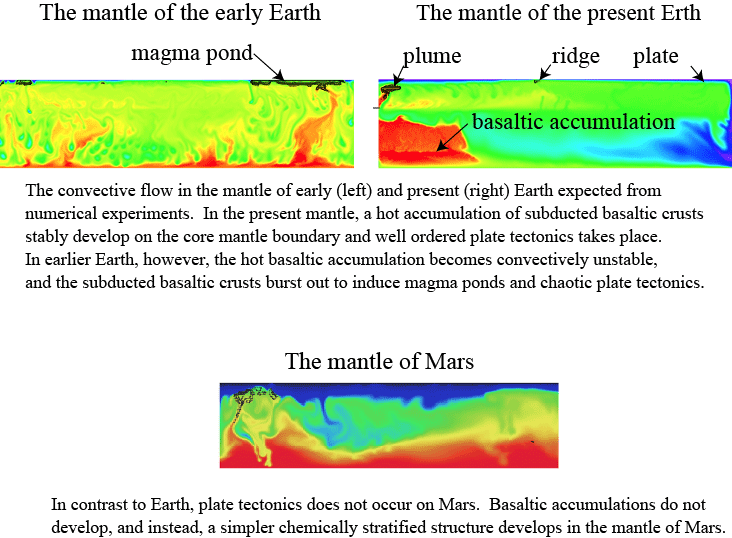Masaki Ogawa (Associate Professor)
Room #801B of Building #16 in Komaba campus, Univ. of Tokyo
Major research subject: Numerical modeling of evolution of terrestrial planets
The thermal and chemical state of the mantles of terrestrial planets like Earth, Mars, and Venus has evolved in their 4.5 billion years history according to (a) the mass and heat transport by convective flow in the mantle, and (b) the chemical differentiation by magmatism. This mantle evolution is a major cause of the evolution of such activities as volcanism on the planets. The mantle evolution is also one of the causes of the evolution of their surface environment. The convective flow is observed as plate tectonics on the surface of Earth; the convective flow at depth in Earth can be guessed from its tomographic image, too. On other terrestrial planets, however, the convective flow is not visible since it occurs beneath the lithosphere as a rigid and stagnant spherical shell of rocks. A fundamental issue in the study of evolution of the terrestrial planets is to understand why the style of mantle convection is so different from one planet to others, how the style of mantle convection has changed, or has not changed, in the history of the planets, and how mantle convection has controlled the tectonic evolution of the planets as well as the evolution of their surface environments. I am challenging the issue through a series of numerical modeling of mantle convection coupled with magmatism. More specifically, the issues I am currently interested in are as follows:
(a) Earth has experienced a major change in its style of tectonic activities 2 to 3 billion years ago, a period known as the Archean-Proterozoic transition. Continents have suddenly begun to grow, and plate tectonics has changed its style greatly during the period. What changes in the dynamic behavior of mantle are behind this change in the activity of Earth?
(b) How do Venus and Mars, where plate tectonics does not occur and the lithosphere behaves as a stagnant spherical shell, have evolved? Why has volcanism continued long only in Tharsis region on Mars? Why did such a vigorous magmatism as the one that generated magma that covered 80 % of its surface take plate on Venus some 0.5 to 1 billion years ago?
(c) Why hasnft the Earthfs mantle gdrunk uph the ocean water despite that the mantle has been dry and can absorb water up to about ten times the mass of ocean water? Namely, why can the ocean exist on Earth?
(d) How has the presence or absence of water on the surface influenced the evolution of the mantle of terrestrial planets?

A list of major works:
Ogawa, M., Shear instability in a viscoelastic material as the cause of deep focus earthquakes, J. Geophys. Res., 92, 13801-13810, 1987.
Ogawa, M., G. Schubert, and A. Zebib, Numerical simulations of three-dimensional thermal convection in a fluid with strongly temperature-dependent viscosity, J. Fluid Mech., 233,299-328, 1991.
Ogawa, M., The Plate-Like regime of a numerically modeled thermal convection in a fluid with temperature-, pressure-, and stress-history-dependent viscosity, J. Geophys.Res., 108, B2, 2067, doi:10.1029/2000JB000069, 2003.
Ogawa, M., Superplumes, plates, and mantle magmatism in two-dimensional models, J. Geophys. Res., 112, B06404, doi:10.1029/2006JB004533, 2007.
Fujita, K., and M. Ogawa, Basaltic accumulation instability and chaotic plate motion in the earliest mantle inferred from numerical experiments, J. Geophys. Res., 114, B10402, doi:10.1029/2008JB006222, 2009.
Ogawa, M., and T. Yanagisawa, Numerical models of Martian mantle evolution induced by magmatism and solid-state convection beneath stagnant lithosphere, J. Geophys. Res., 116, E08008, doi:10.1029/2010JE003777, 2011.